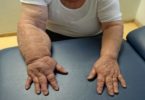What's in this article?
What is Hirsutism?
Hirsutism (HUR-soot-iz-um) is a condition of unwanted, male-pattern hair growth in women. Hirsutism results in excessive amounts of stiff and pigmented hair on body areas where men typically grow hair face, chest and back.
The amount of body hair you have is largely determined by your genetic makeup. Hirsutism may arise from excess male hormones called androgens, primarily testosterone. Hirsutism may also be due to a family trait.
A combination of self-care and medical therapies provides effective treatment for many women with hirsutism.
Causes of Hirsutism
Women normally produce low levels of male hormones (androgens). If your body makes too much of this hormone, you may have unwanted hair growth.
In most cases, the exact cause is never identified. It tends to run in families. In general, hirsutism is a harmless condition. But many women find it bothersome, or even embarrassing.
A common cause of hirsutism is polycystic ovarian syndrome (PCOS). Women with PCOS and other hormone conditions that cause unwanted hair growth may also have acne, problems with menstrual periods, trouble losing weight, and diabetes. If these symptoms start suddenly, you may have a tumor that releases male hormones.
Other, rare causes of unwanted hair growth may include:
- Tumor or cancer of the adrenal gland
- Tumor or cancer of the ovary
- Cushing syndrome
- Congenital adrenal hyperplasia
- Hyperthecosis (a condition in which the ovaries produce too much male hormones)
- Use of certain medicines, including testosterone, danazol, anabolic steroids, glucocorticoids, cyclosporine, minoxidil, and phenytoin
Rarely a woman with hirsutism will have normal levels of male hormones, and the specific cause of the unwanted hair growth cannot be identified.
What are the symptoms of Hirsutism?
The main symptom of hirsutism is thick, coarse, dark hair that grows on parts of the body where it would normally grow as fine, thin hair. For example, hair may grow thicker and coarser on the face, chest, back, lower abdomen, upper arms, or upper legs of women.
How is Hirsutism diagnosed?
Your doctor will conduct a physical examination to determine the extent of the abnormal hair growth, as well as any other physical signs that may be accompanying the hair growth, such as acne.
If your hair growth is diagnosed as hirsutism, your doctor may perform a variety of tests, including blood tests to check hormone levels, ultrasound to visualize the ovaries and uterus, special X-rays, and certain tests to evaluate your ovaries and adrenal glands, in order to rule out other conditions.
Treatments for Hirsutism
If you have more facial or body hair than you want, there are a number of ways you can remove it.
- Weight loss. If you’re overweight and drop pounds, your body should make fewer male hormones, so you should grow less hair on your face or body.
- Shaving. You can remove unwanted hair easily with a razor or electric shaver. You may need to shave daily to avoid stubble growth. Some people get razor burn from shaving too often, but a soothing cream may help.
Risk factors of Hirsutism
Several factors may influence your likelihood of developing hirsutism. These include:
- Family history. Several conditions that cause hirsutism, including congenital adrenal hyperplasia and polycystic ovary syndrome, run in families.
- Ancestry. Women of Mediterranean, Middle Eastern and South Asian ancestry are more likely to develop hirsutism with no identifiable cause than are other women.
Home Care Treatment for Hirsutism
Hirsutism is generally a long-term problem. There are a number of ways to remove or treat unwanted hair. Some treatment effects last longer than others.
- Weight loss in overweight women can reduce hair growth.
- Bleaching or lightening hair may make it less noticeable.
Temporary hair removal options include:
- Shaving does not cause more hair to grow, but the hair may look thicker.
- Plucking and waxing are fairly safe and are not expensive. However, they can be painful and there is a risk for scarring, swelling, and skin darkening.
- Chemicals may be used, but most have a bad odor.
Permanent hair removal options include:
Electrolysis uses electrical current to permanently damage individual hair follicles so they do not grow back. This method is expensive, and multiple treatments are needed. Swelling, scarring, and redness of the skin may occur.
Laser hair removal uses laser aimed at the dark color (melanin) in the hairs. This method is best if a very large area needs to be treated and only if the hair is particularly dark (does not work on blond or red hair).







